 |
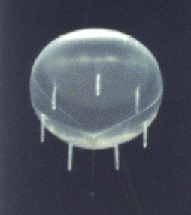 |
|
The Lorenzens, circa 1953 courtesy Project SIGN Research Center |
|
The Sturgeon Bay Incident
Strategic reconnaissance and UFOs
In its January 1953 report, the CIA Scientific Advisory Panel on Unidentified Flying Objects (commonly known as the Robertson Panel) made an observation that has been pointed to for decades as evidence of the US government's seemingly sinister interest in maintaining surveillance on UFO researchers:
UNOFFICIAL INVESTIGATING GROUPS
The Panel took cognizance of the existence of such groups as the "Civilian Flying Saucer Investigators" (Los Angeles) and the "Aerial Phenomena Research Organization" (Wisconsin). It was believed that such organizations should be watched because of their potentially great influence on mass thinking if widespread sightings should occur. The apparent irresponsibility and the possible use of such groups for subversive purposes should be kept in mind.
What specifically attracted the attention of the CIA to a UFO research correspondence club with a few dozen members, based in Sturgeon Bay, Wisconsin, that was as yet nearly unknown outside saucer fandom? Why was APRO (which only later grew into one of the most important UFO study groups in the US) singled out in apparently McCarthyesque fashion as a potentially subversive organization, a threat to national security, within less than a year of its formation?
A number of factors may have a bearing in this, and an overlooked incident from the very earliest days of APRO's existence may provide a clue.
APRO
Coral E. (Lightner) Lorenzen had been interested in flying objects since her own sighting of a parachute-shaped thing floating over a playground in Barron, Wisconsin in 1934. According to her autobiographical recollections in her 1962 book The Great Flying Saucer Hoax, her family doctor loaned Coral one of Charles Fort's books when she was about twelve years old, and the bright girl was launched on a lifelong quest for knowledge about unusual phenomena. When Kenneth Arnold's sighting hit the papers in 1947, Coral collected reports and began corresponding with other saucer researchers around the country. Coral's husband James was an electrical engineer, and they moved frequently to follow his work. Coral was intelligent, organized, perceptive, and had acquired a fair amount of technical know-how. While Jim was stationed in India as an Air Force radioman during World War II, she had run a lathe at a shipyard and had helped build planes at Douglas Aircraft.
From 1949 to mid 1951 the couple lived in Los Angeles while Jim worked as a musician and studied at an electronics school, and in August 1951 they moved to Sturgeon Bay, Wisconsin, where Jim had obtained a job as a radio station engineer.
An avid amateur astronomer and science buff, Coral had been considering starting up a flying saucer study group for some time. In the fall of 1951, twenty-six years old and working as a local correspondent for the Green Bay Press-Gazette, Coral published a few feature articles on flying saucers and was surprised by the volume of mail she received in response. Her saucer correspondence lists were growing, and like Keyhoe, she sensed that the Air Force was trying to cover up a major phenomenon. Coral began to acquire a reputation as the local saucer expert. Reports soon started to filter in to her from around Wisconsin.
In January 1952, Coral and Jim decided to set up a correspondence group called Aerial Phenomena Research Organization (APRO) to serve as a clearinghouse for their information. The major UFO articles in Time and Life that April reinforced her feeling that the Air Force was concerned with something significant behind saucer activities, and her instincts told her that there was a pattern to what was going on. As people plied her with accounts of strange aerial objects, incidents that were sometimes decades old, Coral began to get the feeling that the saucers were up to something systematic. They seemed to be following coastlines, rivers, natural features, overflying strategic sites.
"[UFO] activities indicate that the earth has been the subject of a geographical, ecological and biological survey accompanied by a military reconnaissance of the whole world's terrestrial defenses," she wrote in a later book.
Liddel's Claims
Since September 1947, a small special-projects division of the giant General Mills company of Minneapolis, Minnesota had been flying very large plastic balloons under contract to the Navy and Air Force. These filmy, hydrogen or helium-filled polyethylene bubbles were much lighter than earlier rubber types and were capable of carrying significant payloads to altitudes of 80,000 feet and above -- twice the altitude capability of the aircraft of the time. Early flights were made under contract to the Office of Naval Research (ONR) under the name "Project Skyhook," and carried small stacks of photo emulsion for cosmic ray research.
In February 1951, ONR physicist Urner Liddel launched a public relations blitz based on the theme that the Skyhooks were largely responsible for the flying saucer phenomenon. Liddel's own articles appeared in technical and specialist aviation journals, while newspapers and popular magazines like Look ran pieces on the claims as well. Look's article was typical:
Flying saucers were, and are undeniably real. They are part of a basic research program of the Federal Government which is as important, if not so dramatic, as the visitation from Mars feared by an imaginative public.
The flying saucer is the base of a huge balloon, 100 feet in diameter, called a 'Skyhook.' It is seen by earthlings traveling at speeds up to 200 miles per hour at heights up to 19 miles.
General Mills balloon group personnel had in fact learned that they were sometimes able to track lost or malfunctioning Skyhooks by radio news reports of UFOs. Liddel had launched a study of some 2,000 saucer reports dating back to 1947 and had come to the conclusion that "there is not a single reliable report of an observation which is not attributable to the [Skyhook]."
Look editor Richard Wilson, chief of the magazine's Washington Bureau, wrote that
The lateral rays of the sun at dusk illuminate the base of the balloon....If your imagination soars, the bright reflection on one side may impress you as the glow of an atomic engine....The sun's rays may suffuse the plastic bag with a fiery glow.
Wilson ended his article on the Liddel story with a prophecy:
It can be safely predicted that a year hence there will be a new wave of flying-saucer reports. A new, improved model will be observed by credulous and alarmed citizens of middle America. These observers will be unable to escape the conclusion that the thing in outer space is gaining on us.
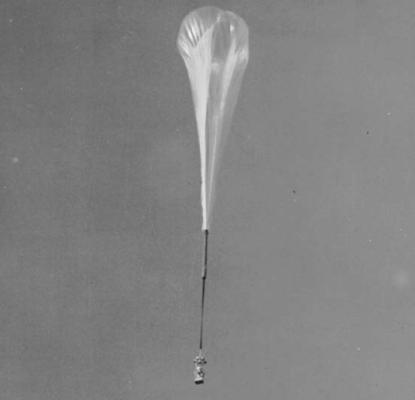 |
Telescopic photo of early General Mills plastic balloon at about 77,000 feet, November 1950
US Navy |
Liddel's claims were exaggerated for effect. Clearly the Skyhooks were not responsible for all flying saucer sightings prior to 1951. It should be kept in mind that he publicized his research as the Korean War had moved into a particularly grim phase, just after entry of the Communist Chinese forces, when concern over possible outbreak of world war was high. By highlighting the link between saucer reports and the balloons, Liddel could have been aiming to reduce the number of false reports, a potential problem in case of a genuine enemy air attack. Interviews with surviving General Mills personnel do substantiate the fact that they were able to track balloons through UFO reports in some cases. Project RAND, which was responsible for pushing the idea of Air Force balloon reconnaissance in the early 1950s, was also well aware of the Skyhook-UFO link, according to its history of the reconnaissance balloon project, and the Air Force's BEACON HILL covert reconnaissance study conducted at MIT from 1951 to June 1952 also noted this connection.
Writing in an internal history of balloon operations in 1959, Air Force historian David Bushnell took note of this peculiar situation:
A further advantage, or disadvantage, of plastic balloons is that from a distance they look remarkably like flying saucers. When floating at ceiling altitude, their configuration is somewhat saucer-shaped, and they can either hover for a week over much the same spot or cruise at 250 miles per hour in the jet stream. They can be seen with an unaided eye glistening at altitudes above 100,000 feet....In addition, metallic masses of more than a ton may be lifted by these vehicles, thus giving radar returns not usually associated with balloons.
By a twist of fate, the Lorenzens had settled about 300 miles due east of the General Mills balloon launch center, what Charles B. Moore called "Earth's largest manufacturer of unidentified flying objects." As knowledgeable as Coral Lorenzen was about objects in the air, it is hard to believe that she was not aware of the General Mills plastic balloons and the Liddel publicity. Her own accounts of sightings she had received while living in Sturgeon Bay in the fall of 1951 make it clear that she was hearing from witnesses who had seen them. For example, she recounts the tale of a man who reported that while driving along the Lake Michigan shoreline near Green Bay one evening in October he had seen a silvery, light-bulb-shaped object drifting high and very slowly to the northeast, where it had disappeared in the distance out over the lake. But evidently she had never seen a giant plastic balloon herself, and she may have already been mentally set against what she saw as previous Air Force debunking explanations for UFO cases such as the Mantell incident.
Project GOPHER
As early as 1946, Air Force Project RAND analysts had proposed using technology similar to the WWII Japanese Fu-Go bombing balloons to create balloons that could fly at constant stratospheric altitudes for long periods of time, carrying photographic reconnaissance payloads over Russia at altitudes above any foreseeable defenses.
Strategic, "pre-hostilities" reconnaissance was a growing concern of the Air Force, which needed accurate mapping of the Soviet Union. The location of military forces and potential Strategic Air Command bombing targets had to be established with certainty. Information also had to be gathered concerning the Soviet nuclear weapons program. US reconnaissance aircraft occasionally penetrated Soviet airspace, but this was too risky. It potentially could lead to war, and the USSR was simply too large for peripheral flights to photograph more than a limited number of targets. Balloon technology seemed to be the only way to get large numbers of cameras over Russia inexpensively and with minimum provocation.
In September 1950, the Air Force Scientific Advisory Board (AFSAB) -- which included Dr H P Robertson as a member in 1950 and 1951 -- studied possible means of solving the strategic reconnaissance problem, and after considering manned reconnaissance aircraft, modified cruise missiles, and satellites, concluded that balloons seemed to be the only feasible near-term solution. In early October, the Air Force established Project GOPHER, classified at the Secret level because of its intended use, to develop a balloon strategic reconnaissance system based on ONR-type Skyhook technology (the Gopher being, of course, the state mascot of Minnesota). At the time, it was anticipated that test flights of the reconnaissance payload would begin as early as February 1951, and operational flights would begin when northern-hemisphere winds were favorable, in the winter of 1951-2. About the time Liddel published his Skyhook-saucer articles, Navy-Air Force turf disputes over use of General Mills Skyhook equipment for GOPHER led to the unusual measure of the Air Force funding ONR management of the GOPHER balloon development program in Minneapolis.
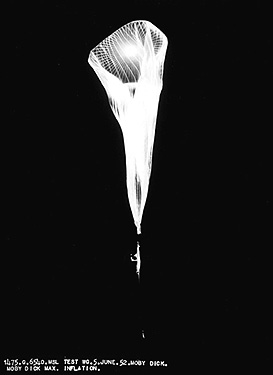 |
As an adjunct to GOPHER, the Air Force developed a research balloon system called MOBY DICK that was designed to gather substantial data on high-level winds. By flying many hundreds of these balloons at various altitudes over periods of months, Air Force weather forecasters could develop a database of knowledge on stratospheric weather patterns. This would be useful both for future high-altitude jet aircraft and for planning launches for the operational GOPHER system. Photo shows a June 5, 1952 MOBY DICK launch from Holloman AFB, NM
USAF |
Time proved that General Mills was having difficulty developing a balloon that was strong enough to carry a heavy camera payload reliably, and test flights dragged through 1951 as balloon after balloon failed for one reason or another. In April 1952, General Mills finally began its flight test program for the GOPHER reconnaissance camera payloads. The balloons used were typical Skyhook-type polyethylene plastic envelopes, about 75 feet in diameter at their cruising altitude of 70,000 feet, but the gondolas were sophisticated, insulated compartments containing ballast control equipment, VHF and HF radio tracking beacons, recording instruments for altitude and temperature, and of course, a reconnaissance camera -- a large K-17 high-resolution instrument rigged to look through oblique windows on the base of the payload package and make exposures at intervals throughout the mission.
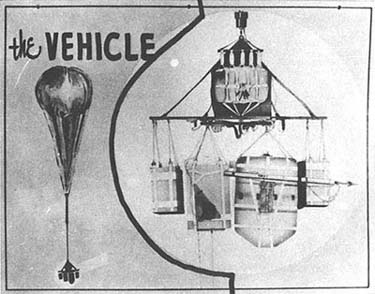 |
At left is a schematic drawing of the 1956 operational version of the USAF/General Mills Weapon System-119L GOPHER/GENETRIX reconnaissance balloon payload, or "gondola." (The size of the payload package relative to the balloon is exaggerated). The close-up of the gondola at right gives an impression of the complexity of the device. A suspension crossbar carried several components. Square ballast boxes on either end held fine steel powder that could be released by magnetic valves to lighten the balloon if barometric switches detected that it had descended below a preset altitude. The larger square box on the left is the control package, containing altitude sensors, batteries and a radio beacon that helped tracking and recovery crews locate the balloon in flight. The camera package is the large box with the tapered underside to the right of center. Above the suspension crossbar is a parachute package, and at top is a motor that would slowly rotate the entire gondola so the camera could take photographs of the ground over a 360-degree panorama. The harpoonlike object was used to aid in recovery from water |
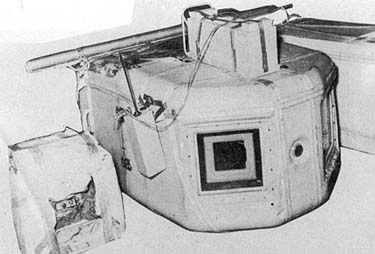 |
A close-up of the base of a 1.5 meter tall, 220 kg GOPHER/GENETRIX camera package. The Boston University-designed K-17 camera used 70 mm film and had 6-inch lenses that looked down through two oblique windows. A photocell activated the camera during daylight hours. The package was insulated with styrofoam to help it survive the extremely low temperatures it encountered at stratospheric altitudes. When
the prototype balloon had accomplished its mission, a chase plane
would orbit below it and transmit a coded radio command to cut the
payload free from the balloon. Descending under four large parachutes,
the camera package would be recovered by ground personnel
|
For details of the operational flights of the GOPHER balloons, see:
Project GENETRIX: Reconnaissance balloons over Russia
On April 14, 1952, the first GOPHER camera test balloon, General Mills Flight 814, was launched from Minneapolis to begin a 23-hour mission. The camera malfunctioned after the gondola bounced hard during the launch. Balloon 824, on April 30, fared a bit better, climbing quickly to 69,600 feet and taking twenty photos during a five and a half hour flight. The next camera test, Flight 843, was to be the most ambitious yet, with a gondola equipped with a rotary head capable of turning the camera through a 360-degree sweep to provide panoramic images. If successful, the balloon's photographs would be turned over to Air Force Intelligence for analysis, and would assist in preparing for eventual overflights of the Soviet Union itself. Flight 843 was scheduled to lift off on June 4.
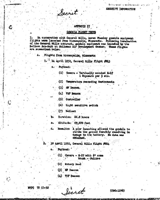 |
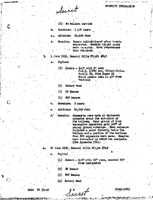 |
Project GOPHER balloon flight schedule, spring 1952 (click to enlarge)
USAF |
At 7:38 Central Standard Time on the morning of Wednesday, May 21, General Mills launched Flight 835, a GOPHER test mission, from University of Minnesota Airport near New Brighton, Minnesota. This consisted of a 73-foot diameter polyethylene balloon carrying a 123-pound telemetry beacon in place of the camera package that operational GOPHERs would use, and was intended to test the ability of the beacon to transmit data about temperatures of the outside air and of the helium gas within the envelope. The balloon was expected to rise to an altitude of 78,700 feet.
The wind was gusty at launch time and the ground crew dropped the payload during preparations, damaging the transmitter. Soon after launch the beacon's radio signal faded out and the balloon was lost to its ground crew as it climbed away.
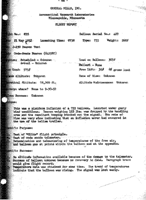 |
Flight report for GOPHER balloon 835 (click to enlarge)
Charles B. Moore |
The Sturgeon Bay Saucer
Around seven o'clock that same evening, Coral Lorenzen was heading for the soda counter at Kellner's Drugstore in Sturgeon Bay. A dance instructor she was scheduled to interview for the Press-Gazette was late for their appointment, and she had decided to kill some time with a cup of coffee. Coral found the main street of the town occupied by a small crowd staring and pointing at the sky. "There's the flying saucer woman," someone shouted. "Ask her what it is!"
"It" was a silvery, elliptical shape glittering high overhead. A saucer. The dance instructor would have to wait. Coral was ready for this, and coolly swung into action, preparing to gather data.
'What is it?' -- 'Is it a flying saucer?' the crowd wanted to know. I told them I didn't know, and immediately wondered if it would be possible to reach someone reliable in the northern part of the county to attempt a triangulation....
She knew what she had to do to accomplish this. She ran into Kellner's, called the local police station, reported the sighting and requested the dispatcher to see if there were any patrol cars north of town, then dashed back to the street and asked if anybody had binoculars. A restaurant manager went inside to look for his pair. Coral looked up at the object just in time to see its underside begin to emit a red glow. She went back to Kellner's and tried to call her husband Jim, who had yet to see a flying saucer. Unfortunately, he was working in the yard and didn't hear the phone. Calling the police dispatcher again, Coral learned that two officers were now watching the thing from a location near Fish Creek, a few miles north of Sturgeon Bay.
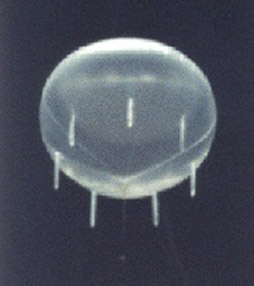 |
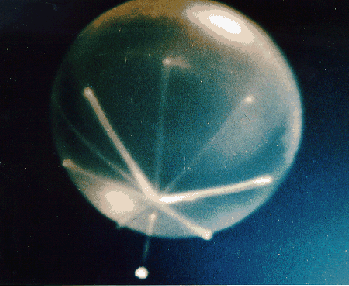 |
Modern research balloons, over 300 feet in diameter, photographed at float altitudes of over 100,000 feet (NASA)
In Sturgeon Bay, the glowing thing was about forty-five degrees above the horizon and appeared elliptical, but at their location the officers saw it as a perfect circle at an elevation of about 60 degrees. All the observers thought the object seemed to be moving very slowly toward the northeast. By this time the restaurateur had found his low-power binoculars, and Coral took them and zeroed in on the saucer.
With the aid of the low-powered [field] glasses we saw the thing as a clearly defined, apparently metallic object. The glow on the bottom was a deep red through the glasses.
As the curious bystanders watched, Coral stood against Kellner's storefront and maneuvered herself until the glowing object was aligned with a TV antenna on a building across the street. She carefully noted her exact position and the object's apparent location relative to the antenna. The thin mast of the antenna almost covered it. By 7:40, the object had moved out of sight in the northeast, along the shoreline of Lake Michigan, and the officers in Fish Creek lost it about five minutes later. The crowd drifted back to more mundane affairs, and Coral went home to tell Jim about the exciting event.
The next day, the Lorenzens returned to measure the angle, elevation and width of the TV mast. They estimated the distance between Sturgeon Bay and the position of the officers in Fish Creek (eighteen miles), employed some basic trigonometry, and came to a shocking conclusion:
The Sturgeon Bay saucer was about 780 feet in diameter, traveling slowly at an approximate altitude of forty miles. In releasing the story we realized that people wouldn't believe or accept the 780-feet diameter, so we stated that it was at least 400 feet wide. We ourselves found the actual measurements difficult to believe, despite the fact that we had worked out all the contributing figures very carefully. [Emphasis in original].
Coral immediately published an article on the sighting. On May 22, General Mills public relations official Louis Champlain stated that the object could have been a balloon that was launched from Minneapolis the previous morning. Coral rejected the explanation out of hand. "The General Mills statement did not attempt to discredit Mr. Lorenzen's triangulation, nor did it mention the fact that the big balloons were considerably less than four hundred feet in diameter and were not equipped with huge riding lights," she wrote. What concerned her most was the brilliant red light the object displayed:
Since that sighting I have given a lot of thought to the nature of that huge (about two hundred and ninety feet in diameter) red light which suddenly appeared on the bottom of the object. Was it possibly some type of special light used in high-altitude photographic techniques? The sun had not gone down, so it wasn't needed for illumination; besides, a light that far from a subject wouldn't light it up to any appreciable extent. [emphasis added]
Impact of the Sighting
It's conceivable that Dr Robertson himself was the member of the CIA Scientific Advisory Panel on UFOs who would have understood the significance of the Lorenzen sighting, given that he had been a member of the 1950 AFSAB committee that had initially approved development of the GOPHER system.
Coral had precisely fulfilled Liddel's prediction of a year before, even down to the description of the bright, fiery glow at the base of the balloon as the setting sun illuminated it. She also had managed to publish an article describing her UFO as a high-altitude reconnaissance vehicle within a month of the GOPHER project's first and only successful full-up, camera-carrying test flight. The GOPHER system was years away from becoming operational. If the object she sighted actually was a GOPHER prototype, the Air Force would not have been enthusiastic about press speculation about its function and appearance, particularly since one of the GOPHER design criteria was to make the system as visually inconspicuous as possible -- something that was difficult to do given the nature of the device.
While General Mills did admit that it had launched a balloon the morning of the sighting, it hardly could have elaborated on the exact nature of the project. In any case, severe friction was developing between the Air Force and General Mills over the delays and problems the project was encountering, and by July the Air Force was preparing to cancel the General Mills contract. After August 1952 the balloon engineering project was taken over by a new company, Winzen Research, and GOPHER development launches were moved to Holloman Air Force Base near White Sands, New Mexico. No more GOPHERs would cross Wisconsin.
Judging by Coral's account in UFOs Over The Americas, her Sturgeon Bay sighting helped provide the stimulus the Lorenzens needed to launch their saucer network. She states that her articles on UFOs produced an unexpected volume of mail from the public, encouraging them to pursue their plans. They mailed APRO's first ten-page UFO newsletter to the club's fifty-two members in July.
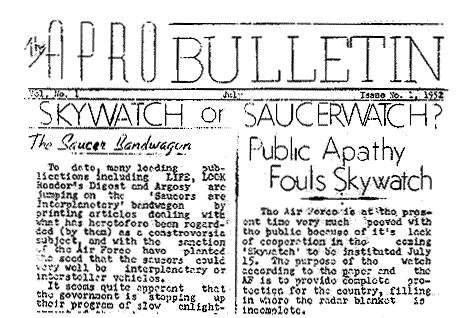 |
|
When considering the Robertson panel's mention of APRO in its January 1953 report, it should be kept in mind that suspicion of subversive activity was at a peak at the time. The United States was at war with two Communist nations in Korea. Julius and Ethel Rosenberg had been convicted of nuclear espionage in 1951 and would be executed in June 1953. The Lorenzens were constituents of the junior Senator from Wisconsin, Joseph McCarthy. A young independent woman with unconventional ideas who published articles questioning the government probably would have come under suspicion in any case in Wisconsin in the early 1950s, but if she happened to write articles obliquely referring to classified reconnaissance systems still under development, chances are very good that her activities would have come under official scrutiny, more for what she might do in the future than for what she had done so far. The comment about APRO in the Durant Report was very much a product of its times.
Perhaps the best way to evaluate the case is as a bit of overenthusiasm on the part of a young woman with passionate beliefs. The fact that in publicizing her ideas Coral Lorenzen drew the attention of government intelligence agencies waging the Cold War is part of the troubled legacy of the UFO phenomenon in the US in the early 1950s.
Evidence that the object was a GOPHER test flight
What are the pros and cons of the identification of the Sturgeon Bay UFO as a Project GOPHER balloon?
Pro:
Documentation exists to prove that a stratospheric plastic balloon was launched from Minneapolis the morning of the sighting, and General Mills stated that the Sturgeon Bay object could have been that balloon. General Mills Flight 835 was launched from Minneapolis at 7:38 AM, and the UFO appeared over Sturgeon Bay at about 7 PM. The distance is approximately 300 miles, implying an average speed of just 25 mph, entirely feasible for a high-altitude balloon.
The object was flying very slowly when sighted and exhibited none of the extreme maneuverability or high speeds displayed by UFOs.
The appearance of the object was identical to that of known Skyhook-type plastic balloons, particularly at sunset when illuminated by low-angle sunlight (sunset at Sturgeon Bay was about 7:20 PM on May 21, 1952).
Con:
Jim Lorenzen's calculations indicate that the object was far too high and too large to be a Skyhook balloon.
The failure of Flight 835's tracking beacon and the fact that the balloon was never recovered make it impossible to be sure that it was over Sturgeon Bay at the time of the sighting.
During her first meeting with Dr J Allen Hynek, in July 1953, Coral Lorenzen asked the Air Force UFO consultant whether the object could have been a balloon. He said that based on her description it probably was not.
Evaluation:
It seems likely that what Coral was attempting to measure was not so much a physical object as the dazzling reflection of sunlight from the GOPHER balloon's shiny surface (or "halation"). A General Mills balloon, flying thirteen miles high, would have been far above any atmospheric haze and mist, and its eight story tall plastic envelope would have functioned as a superb mirror for the low-angle setting sun. This reflected sunlight was so intense, in fact, that people in the northern part of the county could barely stand to look at the object through binoculars. The apparent diameter of the object may have been much greater than its actual size. The low-power field glasses Lorenzen used would not have helped her see much detail on an object at a slant range of at least fifteen miles in any case.
Hynek's denial of the balloon solution is interesting. He obviously knew about the Minneapolis balloon activity, but it is possible that he was not briefed on the reconnaissance aspect. Or he may have been security conscious. In any case, he was probably basing his answer solely on Coral's trigonometry. If he had checked the General Mills launch schedule for May 1952 his answer probably would have been different.
Professor Charles B Moore, who was intimately involved in the development and flight operations of the Skyhook balloon and its derivatives, considers that it is almost assured that the object was General Mills Flight 835, and was able to use Coral's angle and elevation figures to calculate that the balloon was probably at an altitude of about 69,000 feet at the time, 10,000 feet below its planned altitude. Professor Moore provided the diagram below, which shows one method of calculating the altitude of a plastic balloon based on visual observations. Coral mentions that during the sighting the red light suddenly began to glow on the bottom of the UFO; this could have been when sunset occurred.
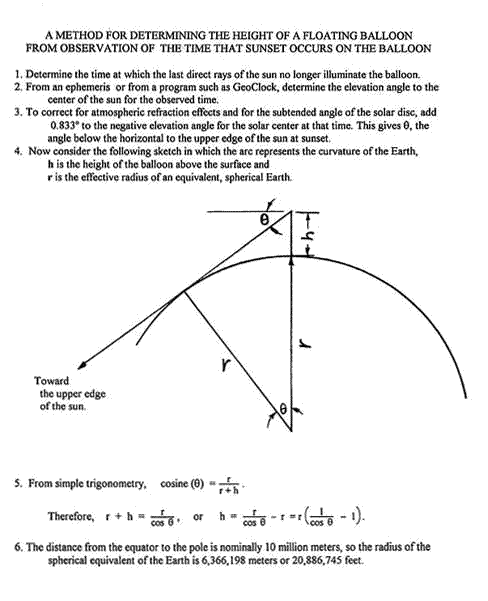
(courtesy Charles B. Moore)
Sources
Bushnell, David, Contributions of Balloon Operations to Research and Development at the Air Force Missile Development Center, Holloman Air Force Base, New Mexico, 1947-1958 (Holloman AFB, NM: Historical Branch, Air Force Missile Development Center, 1959)
Clark, Jerome, "Aerial Phenomena Research Organization," in The UFO Encyclopedia, Vol 2. (Detroit: Omnigraphics, Inc., 1992)
Davies, Merton E and William R Harris, RAND's Role in the Evolution of Balloon and Satellite Observation Systems and Related US Space Technology (Santa Monica, CA: The RAND Corporation, 1988)
Hall, Cargill R, "Postwar Strategic Reconnaissance and the Genesis of CORONA," in Eye in the Sky: The Story of the Corona Spy Satellites Dwayne A Day, John M Logsdon and Brian Latell, eds (Washington, DC: Smithsonian Institution Press, 1998)
Lorenzen, Coral, ed, APRO Bulletin Vol 1, No 1, July 1952 (Many thanks to Mary Castner of CUFOS for providing this)
-, Flying Saucers: The Startling Evidence of The Invasion From Outer Space (New York City: Signet, 1966)
-, UFOs Over The Americas (New York City: Signet, 1968)
Moore, Charles B, correspondence
Peebles, Curtis, The Moby Dick Project: Reconnaissance Balloons Over Russia (Washington, DC: Smithsonian Institution Press, 1991)
Sturm, Thomas A, The USAF Scientific Advisory Board: Its First Twenty Years 1944-1964 (Washington, DC: Office of Air Force History, 1986)